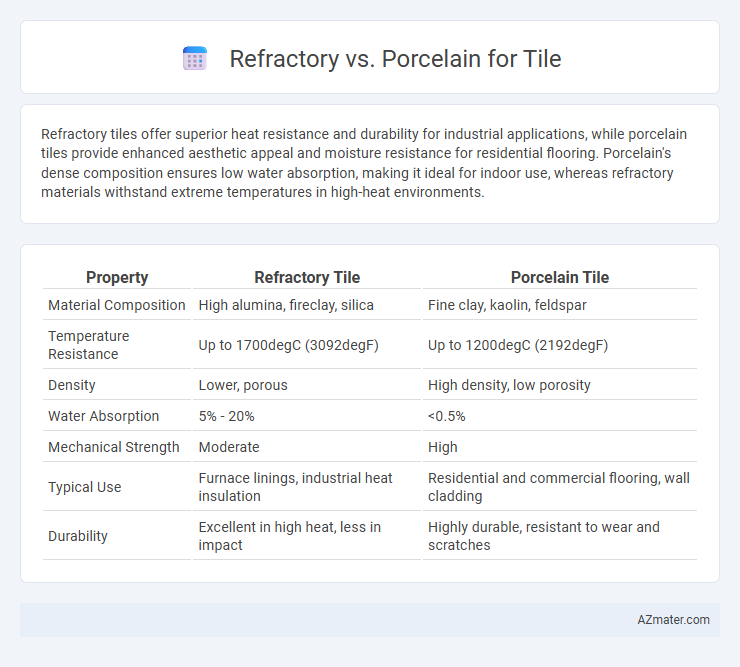Refractory tiles offer superior heat resistance and durability for industrial applications, while porcelain tiles provide enhanced aesthetic appeal and moisture resistance for residential flooring. Porcelain's dense composition ensures low water absorption, making it ideal for indoor use, whereas refractory materials withstand extreme temperatures in high-heat environments.
Table of Comparison
| Property | Refractory Tile | Porcelain Tile |
|---|---|---|
| Material Composition | High alumina, fireclay, silica | Fine clay, kaolin, feldspar |
| Temperature Resistance | Up to 1700degC (3092degF) | Up to 1200degC (2192degF) |
| Density | Lower, porous | High density, low porosity |
| Water Absorption | 5% - 20% | <0.5% |
| Mechanical Strength | Moderate | High |
| Typical Use | Furnace linings, industrial heat insulation | Residential and commercial flooring, wall cladding |
| Durability | Excellent in high heat, less in impact | Highly durable, resistant to wear and scratches |
Introduction to Refractory and Porcelain Tiles
Refractory and porcelain tiles are distinct materials used in construction and design, each offering unique properties suited to specific applications. Refractory tiles are engineered to withstand extremely high temperatures and thermal shock, making them ideal for industrial environments like kilns and furnaces. Porcelain tiles, made from dense, fine-grain clay, provide exceptional durability, water resistance, and aesthetic versatility, commonly used in residential and commercial flooring and wall installations.
Key Differences Between Refractory and Porcelain Tiles
Refractory tiles are specifically engineered to withstand extreme temperatures, making them ideal for furnaces, kilns, and fireplaces, while porcelain tiles excel in durability and low water absorption, ideal for flooring and wall applications. Porcelain tiles consist of fine clay fired at high temperatures that results in a dense, hard surface resistant to stains and scratches, whereas refractory tiles are composed of fireclay or alumina, designed to retain structural integrity under intense heat. The key differences lie in their heat resistance capabilities, material composition, and typical usage environments, with refractory tiles prioritized for thermal insulation and porcelain tiles favored for aesthetic versatility and mechanical strength.
Material Composition and Manufacturing
Refractory tiles are primarily composed of high-alumina and silica materials, designed to withstand extreme temperatures through a sintering process that enhances thermal resistance and durability. Porcelain tiles consist of fine-grained kaolin clay, feldspar, quartz, and other natural minerals, fired at higher temperatures with a vitrification process that results in a dense, non-porous structure ideal for moisture resistance and strength. The distinct raw materials and manufacturing techniques categorize refractory tiles as specialized heat-resistant products while porcelain tiles offer superior hardness and aesthetic versatility for general flooring applications.
Durability and Resistance Properties
Refractory tiles exhibit superior durability and exceptional resistance to thermal shock, making them ideal for high-temperature industrial applications. Porcelain tiles offer high hardness and excellent resistance to wear, moisture, and stains, suitable for residential and commercial flooring. While refractory tiles excel in heat resistance, porcelain tiles provide greater strength and scratch resistance for everyday use.
Aesthetic Options and Design Versatility
Refractory tiles offer a rugged, industrial aesthetic ideal for rustic and outdoor settings, while porcelain tiles provide extensive design versatility with a wide range of colors, patterns, and finishes that mimic natural stone, wood, and even fabric textures. Porcelain's ability to be precisely manufactured allows for consistent sizing and intricate designs, making it a preferred choice for modern, sleek interiors. Refractory tiles excel in high-heat environments but have more limited aesthetic options compared to the expansive styles and customizable surfaces available with porcelain tiles.
Ideal Applications for Refractory Tiles
Refractory tiles are ideal for high-temperature industrial applications such as lining furnaces, kilns, and fireplaces due to their excellent heat resistance and thermal shock durability. Unlike porcelain tiles, which are primarily used for decorative and residential flooring due to their aesthetic appeal and lower heat tolerance, refractory tiles can withstand prolonged exposure to temperatures above 1400degC. Their ability to maintain structural integrity under extreme thermal conditions makes them indispensable in metallurgical, glass, and ceramic manufacturing environments.
Ideal Applications for Porcelain Tiles
Porcelain tiles are highly durable, water-resistant, and ideal for high-traffic areas such as kitchens, bathrooms, and commercial spaces where moisture and wear are concerns. Their dense composition makes them suitable for both indoor and outdoor applications, including facades, pool surrounds, and patios. Compared to refractory tiles, porcelain offers superior aesthetic versatility and ease of maintenance, making it a preferred choice for decorative and functional tiling projects.
Cost Comparison and Budget Considerations
Refractory tiles generally have a higher initial cost compared to porcelain tiles due to their specialized materials and manufacturing process designed for extreme heat resilience. Porcelain tiles offer a more budget-friendly option with competitive pricing while maintaining durability and aesthetic versatility. When considering long-term expenses, refractory tiles may reduce replacement frequency in high-temperature environments, potentially offsetting their upfront investment.
Installation Requirements and Challenges
Refractory tiles demand precise temperature control during installation to prevent cracking, requiring specialized mortar and firing processes to withstand extreme heat. Porcelain tiles offer easier installation due to their uniform size and density but necessitate a stronger adhesive and careful subfloor preparation because of their low porosity and increased weight. Both materials require consideration of expansion gaps and professional grout application to ensure longevity and performance.
Maintenance, Longevity, and Environmental Impact
Refractory tiles offer superior durability and heat resistance, making them ideal for high-temperature applications with low maintenance requirements due to their robust material composition. Porcelain tiles provide exceptional longevity and ease of cleaning, resisting stains and moisture, which reduces the need for chemical cleaners and frequent upkeep. Environmentally, porcelain tiles are often more sustainable, manufactured with natural clay and higher recycled content, while refractory tiles typically rely on energy-intensive production processes that impact their ecological footprint.

Infographic: Refractory vs Porcelain for Tile
 azmater.com
azmater.com